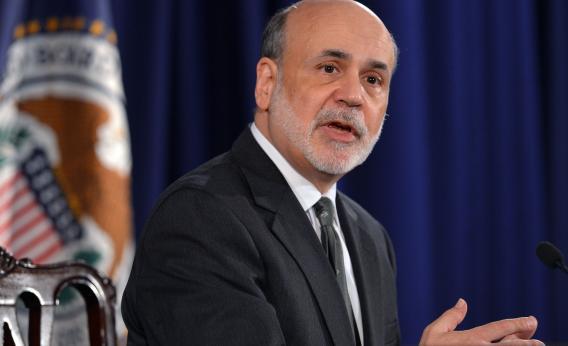“Don’t fight the Fed,” the saying goes. The U.S. Federal Reserve is promising ultra-low interest rates into 2015. Yet the buildup of low-yielding debt on financial firms’ balance sheets means they may suffer badly if rates jump. The central bank aside, prudent bosses – and their watchdogs – need to ensure they are avoiding fights with history, too.
It has been nearly two decades since financial markets had to deal with a serious interest rate shock. Old-timers may still remember 1994, when the Fed jacked up rates by 2.5 percentage points, destabilizing investments that rested on risky foundations. Orange County crumbled under derivative bets, hedge funds imploded and Mexico’s currency collapsed. To younger finance types, that probably seems almost quaint after the carnage seen in 2008.
Yet rising interest rates can be highly toxic to bonds – especially the kinds that investors like insurance companies, banks, pension funds and the Fed itself have been buying by the bucketload. These include U.S. Treasuries, mortgage-backed securities and investment grade corporate debt. Smaller community banks could be particularly vulnerable, since many of them have tried to maximize their income by investing in longer-dated bonds that yield a bit more. The longer the maturity of a fixed income instrument, the more its value will fall as interest rates rise.
The Federal Financial Institutions Examination Council (FFIEC), an umbrella group for U.S. financial watchdogs, put out an all-points bulletin early in 2010 warning regulated firms to be alert to interest rate risk, and followed up early this year with more detailed guidance. The Fed, which is represented at the FFIEC, is party to this appropriate regulatory concern. But the message is undermined by its monetary policy stance, which implies that interest rate risk is a non-issue for at least a couple more years.
But the Fed has only limited power to control interest rates. And sharply higher yields would be far from unusual. For instance, 30-year Treasury bond yields are currently under 3 percent. As recently as last year, they topped 4.5 percent, and in early 2000 they briefly exceeded 6.5 percent. Because of the long maturity, a single percentage point rise in rates would translate into roughly a 20 percent decline in the value of long bonds.
AAA-rated mortgage-backed securities backed by Uncle Sam are also vulnerable. For example, when 10-year Treasury yields rose 1.3 percentage points over four months beginning in October 2010, it shaved about 9 percent off the value of Fannie Mae mortgage bonds, according to a report from Fitch Ratings earlier this year. By way of comparison, that’s nearly double the expected credit losses on prime mortgages originated during the frothy years of 2005 to 2008.
Corporate bonds are also at risk. And in the quest to maximize yield, investors have pushed the duration of outstanding investment grade corporate bonds in a Bank of America Merrill Lynch index – fixed income-speak for the instruments’ sensitivity to changes in interest rates – to record levels. Based on a back-of-the-envelope calculation, every percentage point increase in rates would lead such debt to sink in value by nearly 7 percent on average.
The FFIEC has suggested banks individually test their holdings’ sensitivity to a 4 percentage point interest rate shock. A new study by Welton Investment, a hedge fund, finds that a portfolio of the highest-rated corporate debt would decline by 35 percent if rates surged higher by that amount over the course of a year. That’s not the extreme scenario it might seem. Bonds have been on a 30-year bull run, but interest rate rises of three percentage points or more inside a calendar year used not to be so rare. They happened three times in the 1970s and 1980s. Inflation was the culprit then; simply freeing rates from their zero-bound cage could be the driver next time around. The Welton study also notes that even more modest rate increases can cause significant losses.
Even the Fed itself has loaded up on seemingly safe fixed-income securities, having expanded its balance sheet to a whopping $2.8 trillion thanks to its various bond-buying programs. If rates rise, Chairman Ben Bernanke’s team will find it difficult to reduce its holdings of Treasuries and mortgage bonds without spilling red ink – and losses surely wouldn’t play well in Washington. That’s aside from the problems the U.S. government would face with suddenly higher borrowing costs.
There’s a final wrinkle. The U.S. bank stress tests conducted after the 2008 crisis, which brought higher levels of capital and credibility to the sector, didn’t consider a spike in interest rates. Instead, regulators were focused on how the system would deal with a severe recession, which tends to lead to Treasury yields falling, not rising.
Bernanke is confident that he and his colleagues can manage the retreat from the extraordinary policies the Fed has followed in recent years. He may hold most of the cards for now, but long before 2015 that could change. Any unexpected upward shift in rates will be painful. Maybe before it happens, U.S. watchdogs should ensure higher interest rates are part of their stress tests.
Read more at Reuters Breakingviews.
